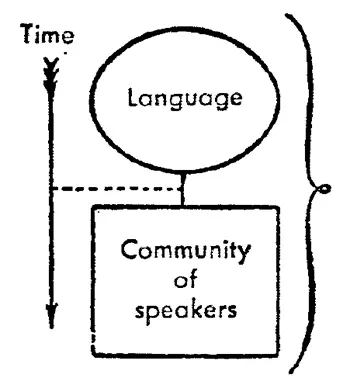Ferdinand de Saussure and Signs
Develop your knowledge and understanding of Saussure’s general principles of signs.
Introduction
Ferdinand de Saussure was fascinated by the science of language and investigated the forces that govern all language systems.
He argued signs consisted of two parts: the signifier (the physical form of the sign) and the signified (concept or meaning). The bond between the two is determined by tradition rather than some sort of natural connection.

The linguist also emphasised how signs acquire their values through their relationships to other signs in the system. The word dark only makes sense when you appreciate its difference to dim and gloomy, up relies on its opposition to down for definition, and how we sequence words into sentences influences their meanings.
Saussure’s sign-system is important because it demonstrates meanings are not fixed and stable but produced through relationships and social convention.
Contents
Signifier and Signified
When we write or say the word tree, we immediately visualise a tree with its long roots, branches and leaves.

The same basic process can be applied to any word. When you see the signifier pull on a door, you know to reach for the handle. If you hear the word stop, you know someone is trying to get your attention. You also know the signifiers pass and fail refer to two very different results in your exams.
We are taught the meanings of these words in school and take their definitions for granted.
Of course, sounds, images and gestures are also signs. Think about how the colour red (signifier) is used on traffic lights and other road signs to warn drivers of dangers ahead and that we should be prepared to stop (signified). Or how blue is associated with boys and pink with girls. There is no obvious connection between the colours and their meanings, but the concepts are well-known and understood.
Consider how we use arrows to signify different directions. They might tell you which route to follow around the school corridors or help you go back and forward a page on an internet browser. It is a very simple but effective system of communication.
Signifiers are the physical forms of the signs we use to signify meanings and concepts.
Signification
The best way to begin exploring Saussure’s principles of signs is to apply the system to media texts and evaluate how they produce meanings. Look carefully and critically at the following logos. Begin your analysis by describing their physical form: colour; shape, form and words. Then suggest why the organisations used these particular combinations of signifiers.




You probably recognised the McDonald’s restaurant from the golden arches formed by the letter M, but can you suggest what other mental concepts the producer is trying to encode? Think about the colour and shape. Are you reminded of anything?
Why did the Conservative Party in the UK use a tree to signify their values and ideologies? You should consider their size and durability.
Examine the logos for FedEx and Amazon and try to find the hidden messages in their design.
The Language System
For signs to have meaning, the system needs to have clearly defined codes, such as a “written set of strict rules of usage” and “orthography”.
Codes
The Swiss linguist used chess to demonstrate his model of communication, explaining to his students how the popular game was not defined by the physical aspects of the chess pieces but the mental concepts we attributed to them through the rules.
For instance, it does not matter if a knight is made from wood or glass because the rules of the game state players can move the piece in an “L” shape horizontally or vertically across the board. The fact it usually resembles a horse’s head has no real bearing on its ability to jump over other pieces in the game to reach its destination. All the other pieces are also governed by the codes and conventions of the game.
In his analogy, the sign consists of the actual chess piece (signifier) and how it moves on the board (signified) according to the rule book (codes). Therefore, signs cannot be understood on their own. Their mental concepts come from their relationship with other signs, so a rook only makes sense when it is compared to a knight according to the conventions of chess.

For a more modern example of codes, you only need to look at your screen and the signs web designers use to encode ideas. The magnifying glass icon at the top is a signifier but its meaning here refers to the ability to search this website for particular theories or theorists. If you are reading this guide to Saussure’s sign-system on your mobile, you can also see the “hamburger” icon, which signifies the menu function.
These popular images convey firmly established ideas and meanings.

In terms of language, you need a good understanding of the rules regarding spelling, grammar and punctuation if you are to interpret a sentence correctly. Without these codes and conventions, the words (or signs) are meaningless.
For another look at this key concept, try our guide to the importance of codes in the study of signs. It has other examples and some tasks to help you get to grips with analysing the construction of meaning.
Paradigm and Syntagm
Saussure argued “everything” in the language system “is based on relations”. He identified two distinct relationships which give signs their values.
When signs are “chained together” into a sequence, such as a sentence, they acquire meaning through the syntagmatic relationship.

Signs also acquire values through their association with similar terms. For example, the concept of north only makes sense because of its paradigmatic relationship with the words we use for directions.
Language is a system of interdependent terms in which the value of each term results solely from the simultaneous presence of the others
Ferdinand de Saussure
If you would like to know more about the two relationships, read our guide to paradigms and syntagms because it goes into more detail.
Sign Values
We have already split signs into two parts: the signified and signifier.
The signification process refers to the bonding of a mental concept with a physical form, such as word tree to signify the mental concept of a tree.
However, Saussure believed “language is a system of pure values” and not “a simple naming-process”. We are going to stick with his money analogy to explain the subtle difference between value and signification.
If you want to determine what a five-franc piece is worth, you need to know it can be “exchanged for a fixed quantity of a different thing”. Saussure would have been able to buy a large basket of delicious treats from the boulangerie for his hard-working students at the University of Geneva in 1910.
A one-franc piece would be the equivalent of ten baguettes in the shop.
We can now appreciate the true worth of the coins because of the difference in quantities exchanged.
Therefore, the value of a sign is only fixed by being part of a system of exchange (signification) and comparison (paradigm). That’s why the word dark makes sense when you appreciate its difference to dim and gloomy.
Arbitrary Nature of the Sign
What is the meaning of the word tree? What mental concept is formed in your mind when you read or hear the word?
Ferdinand de Saussure argued “the bond between the signifier and the signified is arbitrary”. There is no natural reason why the succession of letters or sounds that form the word tree link to the concept of a tree in your mind.
This arbitrary relationship between the two parts of the sign becomes obvious when you appreciate other languages use different signifiers for tree, such as arber in French and crann in Irish.
The meanings of words are fixed by tradition and rules. We are taught to associate tree with the concept of a tree and, by circulating the word with other speakers, we maintain the convention.
The same principle is true for all words in the language system.
Onomatopoeic words might seem directly connected to their meanings. The word tick-tock seems to mimic the sound of an old clock, but the signifier is only an approximation and imitation of the original sound.
Motivated Signs
Saussure recognised language does have patterns and internal logic.
The signifier television is arbitrary. However, the word is formed through the association of tele, meaning at a distance, and vision. The signifier is “relatively motivated” and works effectively to signify the mental concept of viewing something from a distance.
The signifier teacher is also arbitrary and unmotivated, but the word recalls the verb to teach.
There is an arbitrary relationship between the signifiers twenty and nine and their corresponding mental concepts. The signifier twenty-nine is also arbitrary, but the word is motivated through its association to the other terms.
Language always includes elements of absolute arbitrariness and relative motivation.
The Immutability of Signs
The bond between the two parts of the sign might be arbitrary, but Saussure argued the “signifier chosen by language could be replaced by no other”. Signs are fixed because they are part of the language system.
No individual can “modify” signs.
We may not know when the “contract was formed between concepts and sound-images” but signs are a “product of historical forces” which “prohibits any sudden widespread change”.
Saussure identified four main reasons for this immutability:
- The “arbitrary nature of the sign is really what protects language from any attempt to modify if”. We have all accepted tree means tree.
- The “multiplicity of signs necessary to form any language” is an “important deterrent to linguistic change”. Each sign only has value because of its position and contrast with other signs. We understand the mental concept of tree because of its difference to bush and plants. This interdependence means signifiers are resistant to change.
- The system is “a complex mechanism” and ruled by some internal logic. Signs are often motivated, making it difficult to modify signifiers such as treehouse and treeless because they rely on the word tree.
- There is also a “collective inertia toward innovation” because it is easier for everyone to participate in maintaining the language system. We would all need to agree to exchange tree for another signifier.
That’s why the signifier tree will continue to correspond to the mental concept of a tree.
The Mutability of Signs
Signs are maintained through tradition and practice. However, language does change because it is influenced by context.
The arbitrary relationship between the signified and signifier gives us the freedom to establish new signs. It could a small change in the pronunciation of the signifier or how it is spelt, such as moving from hoofs to the modern standard hooves.
Mental concepts can also change. For example, we no longer use the word tree to signify wood and timber.
The mutability of signs is “inescapable” because language belongs to a community of speakers. We may not fully understand the cultural and social forces affecting the signs we use to exchange ideas and express our feelings, but time always results in a shift in the links between the signified and the signifier.

Psychological Process
It is also worth emphasising Saussure’s argument that signs are “a two-sided psychological entity” with the concept (signified) being a “counterpart” to the sound-image (signifier). Read our guide to the speaking circuit for more information.
Final Thoughts
Saussure’s scientific approach to understanding signs remains an important model for studying any media product. By identifying the dominant signifiers and appreciating how they combine to create meaning, we can develop a better understanding of the message being conveyed by the producers.
Remember, you can refer to the signifier in the examination but a proper explanation of what they signify could be more important in terms of your marks.
Decoding Semiotics
The study of signs helps us understand how meaning is constructed through language. Explore more posts analysing media texts through this critical framework.







